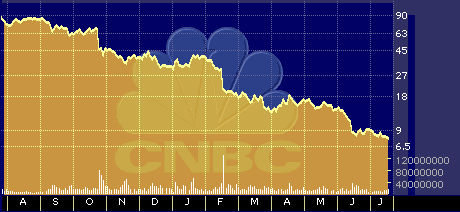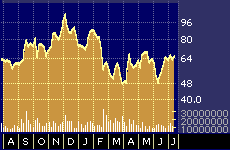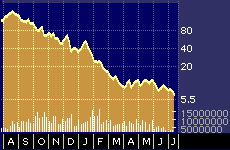
Analysts Like Nortel As Tech Leader
Analysts Like Nortel As Tech Leader
By Hal Plotkin
Silicon Valley Correspondent
Looking for a market-proof tech stock not just for today, but for the long run, too? Wall Street analysts continue to ride on the bandwagon for Nortel Networks Corp. {NT}, rather than recently grounded high-flyers Qualcomm Inc. {QCOM} and Sycamore Networks Inc. {SCMR}.
Analysts say investors should benefit from Nortel’s runaway growth in wireless and optical networking markets without exposing themselves to all the risks associated with more volatile pure play stocks in those sectors.
Last Thursday, New York-based Chase H&Q analyst Michael Neiberg upgraded Nortel Networks Corporation from a “buy” to “strong buy” rating, setting a 12-month price target of $75 for the stock.

One-year chart for NT
“Business remains strong in all the key areas, most notably in the company’s optical and wireless groups,” Neiberg wrote. “We believe the company’s market leadership position in optics is widening [while] new contracts in wireless infrastructure signify market share gains and building momentum.”
“I am very positive on Nortel,” agrees Ariane Mahler, an analyst at Dresdner Kleinwort Benson, based in New York. “I think we’ve only seen the beginning of the optical wave which I think is going to extend much further than anyone has so far estimated. The other big engine of growth for Nortel is wireless which I don’t think has been factored into the models enough.”
Mahler currently has a “strong buy” rating on the stock along with a $90 12-month price target.
The analysts say Nortel’s size and leadership in optical networking and wireless markets makes it a safer way to ride the growth curve in those fast-growing telecommunication industries, as compared with smaller less diversified players.
Pure play optical networking and wireless stocks have been one of the most lucrative, and most risky, investments over the past few years.
Qualcomm Inc., {QCOM} for example, which has market leading wireless technology and a much talked about huge pending deal in China, is down sharply from the high of $200 it hit late last year. Likewise, leading optical networking supplier Sycamore Networks Inc. {SCMR} has also lost more than half its market cap over just the past three months.

One-year chart QCOM

One-year chart for SCMR
The overall market for fiber optic components is projected to grow to $21.3 billion by 2003, up from last year’s $5.5 billion, according to International Data Corporation, based in Framingham, Mass. Demand for optical networking products could skyrocket to as much as $150 billion by 2005, according to other estimates.
Projections of future growth in wireless markets are equally ambitious, with many analysts now saying wireless communications will eventually become the dominant telecommunications channel.
The analysts backing Nortel say the company will thrive regardless of which smaller wireless or optical networking suppliers gain the most ground.
In a sign the company is on the right track, Nortel recently told analysts it would reach its stated goal of $10 billion in optical revenues for fiscal 2000, barring any unforeseen manufacturing glitches.
Sales of Nortel’s optical products have been particularly strong in recent quarters, growing by more than 150 percent during the first quarter of this year as compared with the year-earlier period.
“This compares favorably to Lucent’s optics business, which is expected to grow 50 percent to roughly $6 billion, implying that Nortel is widening its market share lead,” wrote Neiberg, of Chase H&Q.
Nortel also made a major announcement in the wireless arena last week, confirming that it has been selected by British Telecommunications’ {BTY} wireless division, BT Wireless, to be the principal supplier of that firm’s next generation wireless network. The contract is valued at over $700 million over the next two to three years.
“Nortel is our top pick among system companies,” says James Parmelee, an analyst at Credit Suisse First Boston, based in New York. “They’re leveraging wireless, broadband, and optics more than Cisco.”
Parmelee says Nortel’s stock should outperform the market even if concerns about interest rates leave most other stocks moving sideways over the next few months.
“When it comes to Nortel I think we’re looking at upside potential to revenue estimates and upside surprises in gross margins. You’ve already seen the stock correct in the last several months. We think the timing is now excellent to buy Nortel shares.”
The recent fallback in Nortel’s share price has left even some more skeptical analysts showing renewed signs of interest.
A.G. Edwards and Sons analyst David Heger, for example, is maintaining his lukewarm “accumulate” rating on the stock, his firm’s second-highest rating, for the time being.
But he says Nortel’s stock is beginning to look attractive to him on a pure valuation basis.
“I’m close to the point where I’d be looking at changing our rating,” he says, calling the $50 price level his “trigger point.”
“It’s still at somewhat of a premium,” he says. “But overall I like the outlook for the company, it’s still very solid, and the shares have finally come down to a more reasonable level.”
On April 25, Nortel Networks reported earnings of 23 cents per share for the company’s FYQ100, nine cents per share ahead of the same period last year but three cents under the Street’s consensus earnings estimate for the quarter.
The company’s president and chief executive officer, John Roth, issued an upward revision of his overall growth expectations along with Nortel’s most recent quarterly report. Roth says he now expects revenue growth in 2000 to be in the 30 to 35 percent range as compared with last year, up from his previous growth estimate of 20 to 21 percent.
Growth in earnings per share from operations in 2000 compared with 1999 should also come in around 30 percent, according to the company’s most senior operating officer.


